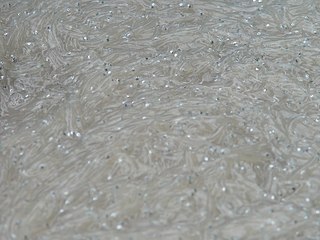
The New Zealand smelt, also known as the New Zealand common smelt, New Zealand cucumber fish, or silveries is a smelt of the family Retropinnidae, found only in New Zealand at shallow depths in estuaries and rivers. Their length is between 8 and 13 cm.
Cucumberfish is a common name for several fish and may refer to:

Slickheads, also known as nakedheads or smoothheads, are deep water fishes that belong to the family Alepocephalidae. They are most commonly found in the bathypelagic layer, which is approximately 3000m below the surface. They get their name from the lack of scales on their heads. Similarly, the scientific name is from the Greek ᾰ̓- (a-, "not"); λέπος (lepos, "scale"); and κεφαλή (kephalē, "head"). It has about 22 genera with ca. 96 species.
Paracalliope is a genus of amphipod crustaceans that live in Australasia. They include the most common freshwater amphipods in New Zealand, where they are particularly frequent in slow-flowing reaches of rivers. They shelter among weed beds and are important prey items for fish such as the New Zealand smelt, Retropinna retropinna, which are in turn important prey for the freshwater eels Anguilla australis and Anguilla dieffenbachii. Paracalliope acts as an intermediate host for the nematode Hedruris spinigera, which can thus reach their primary host, the eel.

The Australian smelt is a small, pelagic silvery freshwater fish found in large numbers in waters of the south eastern Australian mainland.

Abergasilus amplexus is a species of parasitic copepod endemic to euryhaline habitats in New Zealand. It is the only known species in the genus Abergasilus.

Poeciliopsis is a genus of poeciliid fishes that primarily are native to Mexico and Central America. The only exceptions are P. turrubarensis where the range extends into Colombia, and P. occidentalis where the range extends into Arizona and New Mexico.
Shorea leptoderma is a species of plant in the family Dipterocarpaceae. It is a tree endemic to Borneo where it is confined to Sabah. It grows in lowland rain forest.

Whitebait is a collective term for the immature fry of fish, typically between 25 and 50 millimetres long. Such young fish often travel together in schools along coasts, and move into estuaries and sometimes up rivers where they can be easily caught using fine-meshed fishing nets. Whitebaiting is the activity of catching whitebait.
Hedruris spinigera is a parasite belong to phylum Nematoda, commonly found in the stomach of freshwater fish. The female Hedruris spinigera attaches itself onto the epithelium of the fishes' stomach using a hook at the curved tail. Meanwhile, the male swims freely until it finds a female that has already attached to a host, then the male curls around the body of that female so that sexual reproduction occurs within the host. Most fishes consume Paracorophium excavatum, the intermediate host for Hedruris spinigera; however, the prevalences of Hedruris spinigera are restricted to certain host range.
Genetypes is a taxonomic concept proposed in 2010 to describe any genetic sequences from type specimens. This nomenclature integrates molecular systematics and terms used in biological taxonomy. This nomenclature is designed to label, or flag, genetic sequences that were sampled from type specimens. The nomenclature of genetypes proposes that genetic sequences from a holotype should be referred to as a “hologenetype”, sequences from a topotype should be a “topogenetype”, and so forth. In addition, the genetic marker(s) used should be incorporated into the nomenclature.
Leptoderma is a genus of slickheads found in the deep waters of the oceans.

Retropinna is a genus in the family Retropinnidae containing one species that is widespread in southeastern Australia, one from Tasmania and one from New Zealand.

The Nyeri Nyeri is an indigenous Australian people whose traditional territory is in the Mallee region of Victoria.
Leptoderma ospesca, the eastern eel-slickhead, is a species of slickhead found in the eastern-central Pacific Ocean.
Leptoderma affinis, the eel slickhead, is a species of slickheads found in the Indian Ocean.
Leptoderma lubricum is a species of slickheads found in the western Pacific Ocean.
Leptoderma macrops, the grenadier smooth-head, is a species of slickhead found in the eastern Atlantic Ocean.
Leptoderma macrophthalmum is a species of slickhead found in the Atlantic Ocean.







